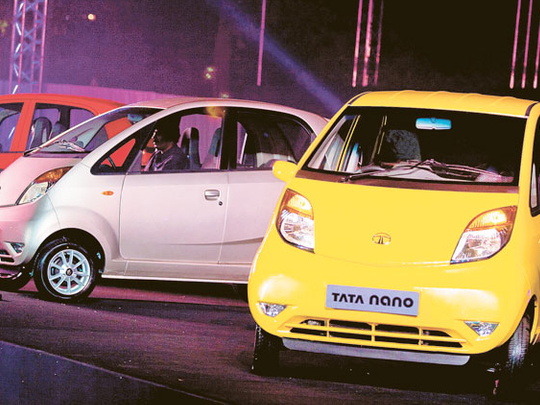
Mumbai: Ratan Tata wants another shot at promoting the Nano, conceived by the Tata Motors Ltd chairman as the world’s cheapest car and whose sales plunged and never fully recovered after at least three caught fire.
The Nano, which starts at Rs141,898 ($2,555; Dh9,382) was developed as an upgrade option for millions of Indian motorcycle owners. First introduced in 2009, demand fell to a record low of 509 units in November 2010 after the cars caught fire.
Sales have since lagged behind pricer models even after the company said the fires were isolated incidents.
“The Nano is something I would love to make successful because I don’t think it’s exploited its full potential right now,” Tata said in an interview with Bloomberg TV India. “There has to be another push to make Nano what it can be.”
Tata, due to retire in December after running the Tata group for two decades, decided to develop the car after seeing a family riding on a scooter. The car faced problems even before sales began, with the company having to abandon a near-complete factory in West Bengal state because of violent protests by farmers demanding the return of land acquired for the site.
After the fires, the company in December 2010 lengthened warranties to four years or 60,000 kilometres and started offering as much as 90 per cent financing through unit Tata Motors Finance Ltd.
An increase in borrowing costs however pinched the budgets of consumers that Tata Motors targeted to upgrade from motorcycles. Many chose the cheaper two-wheelers instead, hitting sales of the Nano.
New features
“Tata will have to refresh the Nano with new features as competitors such as Maruti and Hyundai are also stepping up their efforts,” said Umesh Karne, an analyst at BRICS Securities Ltd in Mumbai. “If they manage to introduce new features and maintain a competitive price, I think its possible to resurrect the Nano.”
Tata said in January that the automaker is working on the vehicle’s upgrades to undo the “stigma” attached to the hatchback. The company wasn’t “adequately ready” with advertising campaigns and a dealer network when it started sales of the car in 2009, he told reporters then.
The automaker introduced a new version of the compact with a more powerful engine in November and said in December that it would change the starter motor in about 115,000 Nanos as part of efforts to improve the vehicle’s performance.
Nano sales
Tata Motors sold 5,485 Nanos in July, an increase of 68 per cent over the same period a year earlier though still a fraction of the 20,000 units a month the dedicated factory in Sanand in the western Indian state of Gujarat is capable of making.
The Mumbai-based automaker sold a total of 74,527 Nanos in the year ended March 31, giving it a 10 per cent share in the mini and micro car segments, according to data from the Society of Indian Automobile Manufacturers. Maruti Suzuki India Ltd, rocked by worker riots last month, sold 491,389 units in the same period for a 69 per cent share.
Tata Motors chose the first 100,000 customers for the Nano through a lottery from the 206,703 orders it got in the initial sales period in April 2009. The car was first displayed at the New Delhi auto show in 2008.
“The fact that we did achieve what we set out to achieve to design and build an affordable family car for the people is an achievement I was very proud of,” said Tata.
“I would love to be involved rather than think this is the level that” Nano sales can be, he said.












